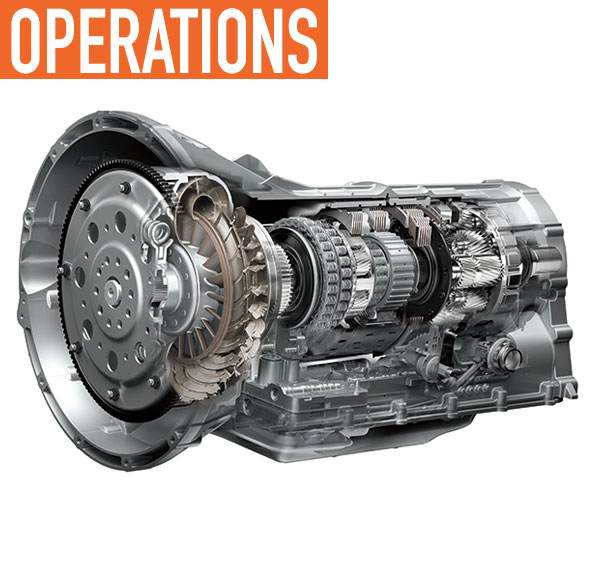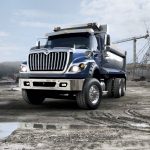Holman Parts Distribution, a leading provider of strategic powertrain sourcing solutions specifically developed for the fleet industry, understands that for most companies, the fleet is critical to supporting day-to-day business operations. For these vocational fleets, a comprehensive powertrain sourcing strategy can help minimize a fleet’s long-term cost of ownership while also optimizing vehicle uptime to support core business functions, driving value to the company’s bottom line.
The vehicles in a typical vocational fleet are more than just vans and trucks; they are important tools that employees need to support day-to-day business operations. Extended—or repeated—downtime due to on-going maintenance issues can quickly impact a fleet’s productivity, often resulting in a significant loss of revenue. A thorough, strategically developed maintenance program that is executed with meticulous attention to detail can be the difference between hundreds, if not thousands, of dollars through the course of a vehicle’s lifecycle—not only in regards to operating costs, but also in terms of the vehicle’s productivity.
PARTS SOURCING
Vital to any comprehensive fleet maintenance program is a strategic parts sourcing initiative. For many vocational fleets, the best value may be the part or component that minimizes vehicle downtime rather than the one with the lowest invoice. The proper care and maintenance of an asset’s powertrain components is essential, and equally as important is the strategy that is in place to repower a vehicle in the event of a powertrain component failure.
When a powertrain unit needs to be replaced, fleet managers are faced with the option of using OEM parts or reverse-engineered alternatives. Both OEM and reverse-engineered units have their pros and cons, but for most fleets, genuine OE powertrain units strike the best balance of quality, reliability, and long-term value.

For fleets that prioritize durability, performance, and peace of mind, the smart choice is typically the powertrain unit that provides the best overall value and not the unit that simply has the lowest, one-time invoice—especially when a subpar solution may significantly hinder day-to-day business operations.
OEM powertrain units are built to withstand the rigorous demands of commercial use and also provide the ideal combination of value, performance, and reliability that is coveted by most vocational fleets, helping to control operating expenses and minimize vehicle downtime.
These units deliver the convenience and confidence fleets need, keeping vehicles on the road to support core business functions and ultimately allowing fleet personnel to focus on vital strategic functions rather than the day-to-day administrative burden typically associated with repeated component failure and on-going maintenance issues.
PROPRIETARY ENGINEERING
Such manufacturers as FCA, Ford, and GM create the proprietary powertrain blueprints through a lengthy and rigorous product development process that is spear-headed by many of the industry’s leading engineers. These comprehensive designs and data encompass the exact specifications, material composition, and original tolerances required to ensure proper performance. And, since this intellectual property is not available to other companies, reverse-engineered alternatives may be imprecise, failing to meet the original specifications of the OE manufacturers.
Given the current landscape of the automotive industry, access to proprietary manufacturing information is more important than ever. Competition fuels innovations and the automotive industry is arguably one of the most competitive business sectors globally. Manufacturers constantly strive to increase performance, maximize efficiency, and improve reliability. With these goals in mind, OEMs are pushing the limits of design complexity and mechanical operation. The manufacturing tolerances are often razor thin and nearly impossible to replicate through reverse-engineering.
ENSURING AN EXACT FIT
Another benefit of OE powertrain products is that all units are engineered to the exact specifications required for each make, model, and year, ensuring proper functionality. As a result of this application-specific fit, OE powertrain assemblies maximize vehicle performance, efficiency, and reliability, helping to minimize the long-term cost of ownership. OE manufacturers also incorporate the latest product updates and engineering enhancements—updates and enhancements that only the OE engineers have access to.
REMAN PROCESS
Key to delivering reliable powertrain assemblies is the remanufacturing process itself, and as vehicle technology continues to evolve at breakneck speeds, so must the engineering procedures. The high-quality components used during remanufacturing are absolutely critical to the process. Core materials are subject to an extensive inspection process and most OE remanufacturers will discard cores with any concerns or potential damage. Suppliers of reverse-engineered units typically do not adhere to the same rigorous core inspection standards and will often use cores that the OEs reject.
The remanufacturing process also often employs the same machinery and procedures used during the original manufacturing process with the intent to return each unit to like-new condition that meets original OE specifications. This attention to detail also extends to the sub-components used during manufacturing.

Most OE remanufacturers opt to use new, OE-approved sub-components rather than less expensive aftermarket options. These OE powertrain assemblies often include new components, such as oil filters, thermostats, oil pan, water pump, etc. Many reverse-engineered alternatives use either aftermarket components or do not include these items at all, which may result in increased labor time and additional cost for parts that need to be purchased or swapped from the replacement unit.
It is also important to note that each factory is subject to stringent OE testing procedures with most units being tested on a dynamometer or on computer-controlled test stands to verify performance prior to shipping. These standards are typically derived from extensive laboratory and road testing during the initial R&D process, ensuring maximum efficiency and performance.
OE POWERTRAIN UNITS
A general misconception in the fleet marketplace is that OE powertrain units typically cost more than their reverse-engineered alternatives. However, this often is not the case, especially when you consider the additional components that may be required for the reverse-engineered units along with the associated labor time to install these parts. When assessing the cost of a replacement powertrain assembly, it is important to examine the total value of the OE product rather than just the onetime unit cost.
As previously mentioned, many OE powertrain units are fully dressed with most subcomponents and ready for installation. While these subcomponents are relatively inexpensive on an individual basis, together they quickly add to the overall cost of a unit. The typical reverse-engineered assembly arrives essentially stripped of these vital parts, requiring potentially significant labor time to dress the unit for installation.
Most repair facilities estimate approximately three hours to properly prepare a stripped engine for final installation. With an average labor rate of $100 per hour, that is an additional $300 just to ready the assembly for installation—along with the additional vehicle downtime and lost productivity.
Another important factor to keep in mind is that most reverse-engineered units are subject to core deductions. However, nearly every OE manufacturer offers a no risk core policy meaning a 100-percent core credit regardless of damage or the quality of the returned core. This no-risk return policy helps to ensure accurate price quotes for engine and transmission replacements, avoiding “surprise” core deductions on the invoice. The typical OE core policy only requires that the same unit is returned—like-for-like—in the packaging the replacement unit was delivered in and drained of all fluids.
WARRANTY AND SUPPORT
All OE powertrain units are expected to meet or exceed the manufacturer’s strict performance and reliability standards. However, in the unlikely event that a unit does not perform as intended, these units are backed by best-in-class warranties and customer support direct from manufacturers that are committed to remedying the situation as quickly as possible.
Additionally, all OEM warranties are directly supported by the manufacturer, meaning fleets can work with either the original service location or any dealership nationwide should an issue arise, helping you get vehicles back on the road as quickly as possible. Should a reverse-engineered unit not perform as intended, the warranty process is often complicated with several restrictions typically in place. Many suppliers of reverse-engineered powertrain units restrict warranty services to their pre-approved repair facilities, potentially resulting in additional downtime and lost productivity, because the preferred vendor is farther away or may not have the capacity to complete the repair in a timely manner.
Another stark difference in warranty coverage is the labor rate honored by the powertrain manufacturers. The vast majority of reverse-engineered manufacturers limit the labor rate to either a flat price or a pre-approved rate that is often well short of a repair facility’s actual cost. Nearly all OE manufacturers will honor the shop’s posted labor rate, fortifying positive relationships with vendors and translating into better overall service for the fleet and its drivers.
THE IMPACT FOR FLEETS
In today’s economic environment, fleet managers are faced with continually shrinking resources and more than ever are being asked to do more with less. Most fleet managers face unrelenting pressure to identify cost savings opportunities while simultaneously increasing efficiencies. As a result, many large vocational fleets will benefit from a centralized, OE-focused powertrain sourcing program that helps to minimize their administrative burden while also delivering consistent pricing, nationwide availability, and best-in-class warranties.
The logical solution for most vocational fleets is to commit to a comprehensive OE powertrain strategy that helps to minimize the long-term cost of ownership and maximize vehicle uptime, optimizing fleet vehicles by keeping them on the road to support core business functions and drive value to the company’s bottom line.
FOR MORE INFORMATION:
Find out more about Holman Parts Distribution products and services, visit www.holmanparts.com.
_______________________________________________________________________
MODERN WORKTRUCK SOLUTIONS: MAY 2017 ISSUE
Did you enjoy this article?
Subscribe to the FREE Digital Edition of Modern WorkTruck Solutions magazine.
![]()




